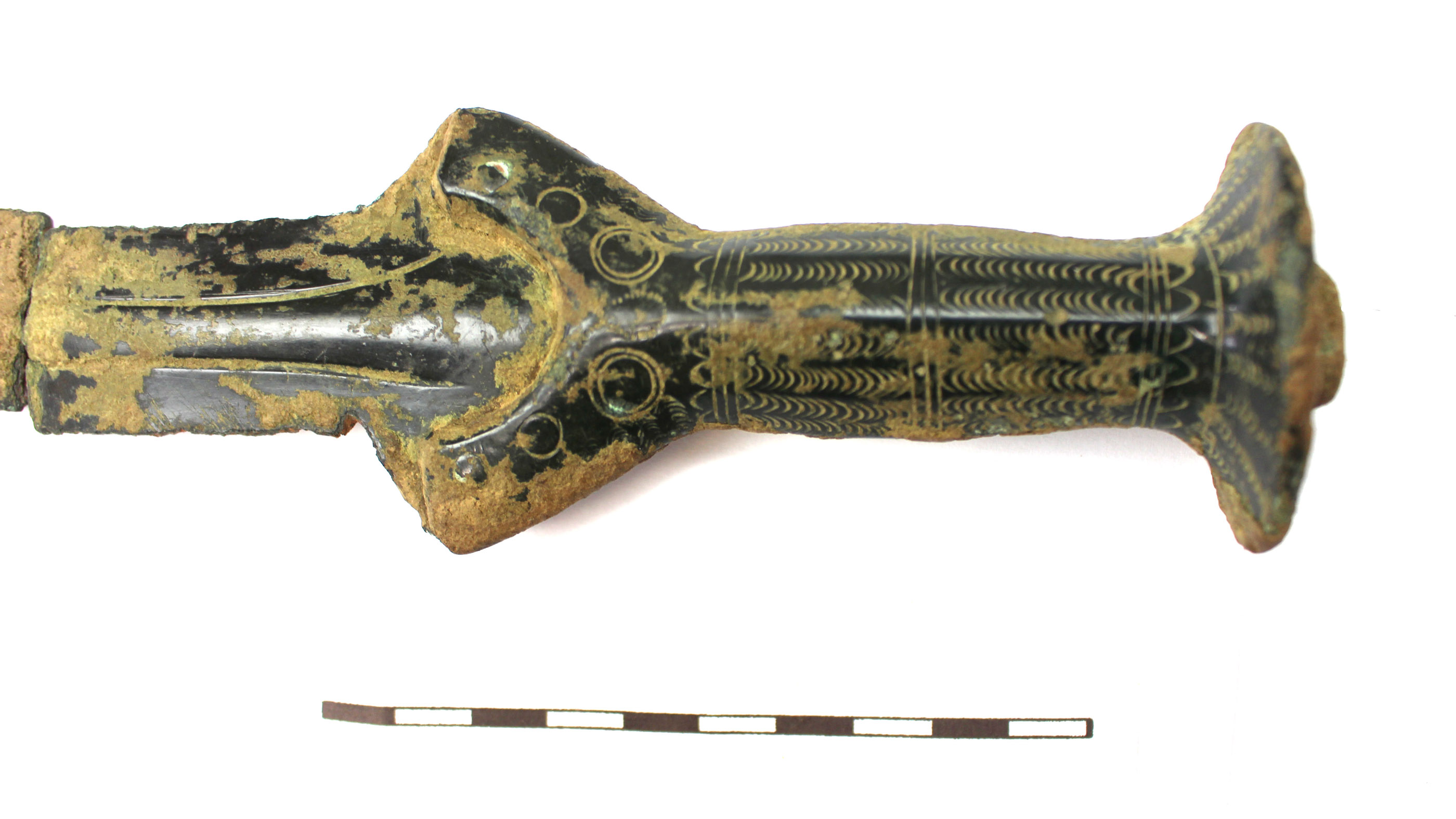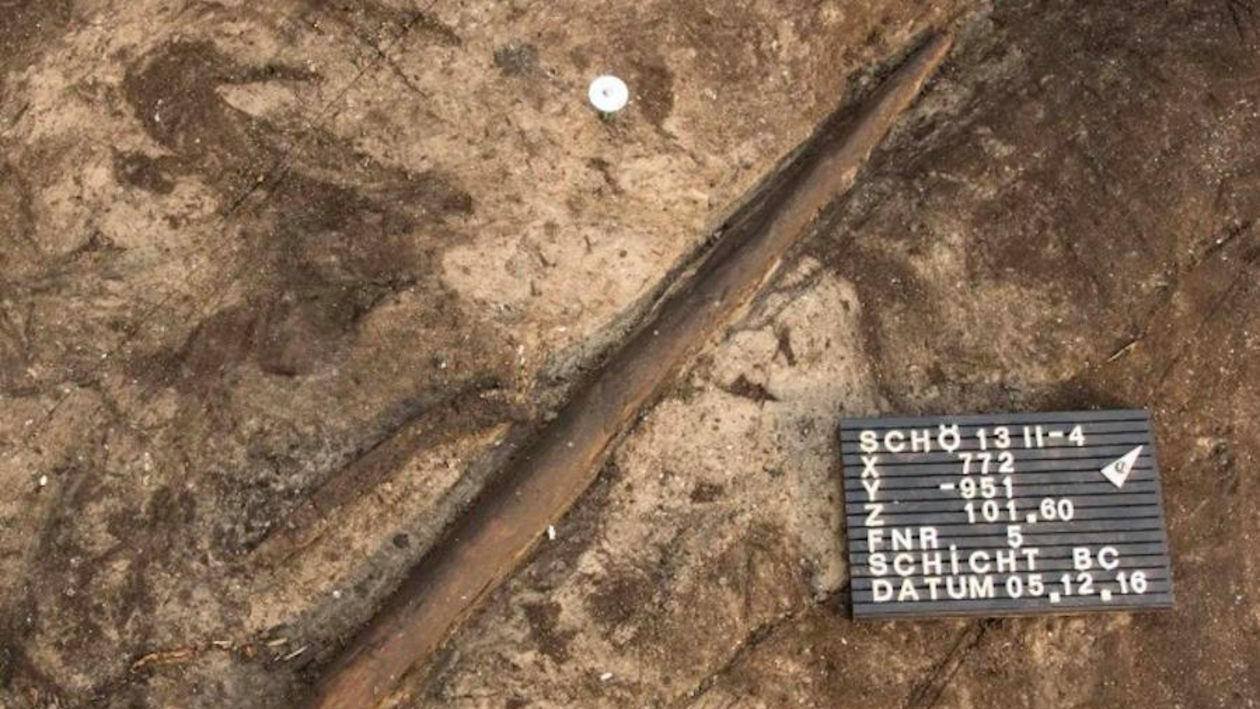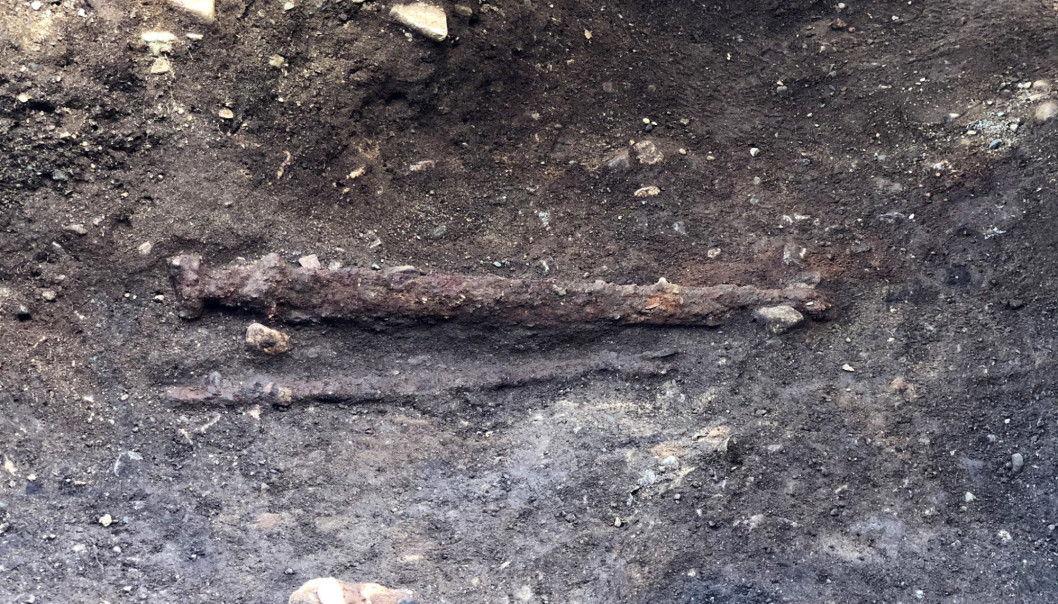The coolest ancient weapons discovered in 2020
Archaeologists unearthed amazing swords, daggers and other weaponry this year.
Ancient swords, elaborate daggers, even early artillery — 2020 turned up a number of intriguing ancient weapons that tell the story of the violence of the past. These discoveries cover hundreds of thousands of years of human history, ranging from the ice age to medieval times.
An ice age throwing stick
The first stop in our weapons tour takes us to the ice age, where the now-extinct human species Homo heidelbergensis used tools to hunt. Measuring about 25 inches (64.5 centimeters) long, this throwing stick found in Germany was first reported in April in the journal Nature Ecology & Evolution. It dates back a whopping 300,000 years and would have been used to wound or kill small prey, like rabbits, swans and ducks, according to the University of Tübingen. Homo heidelbergensis also used spears and long lances to hunt. Most of these wooden weapons are long gone, but the German site of Schöningen preserves exceptional examples of this ancient hunting tradition.
A very old sword
What was thought to be a medieval sword sitting in an obscure museum is actually one of the oldest swords ever discovered.
The simple weapon was spotted in the San Lazzaro degli Armeni monastery by then-student archaeologist Vittoria Dall'Armellina. Though the sword was labeled as only a few hundred years old, Dall'Armellina recognized that it looked far more like a weapon from the Bronze Age than a medieval artifact. She and her colleagues analyzed the sword and found that it is indeed a copper-arsenic alloy from the early Bronze Age, about 5,000 years ago. The sword hails from Anatolia, or what is now eastern Turkey, where swords were first invented.
A beautiful hilt

A mushroom hunter in the Czech Republic was out in the woods this spring when he discovered far more than delectable fungi.
Sticking out of the soil was a piece of metal. Mushroom hunter Roman Novák kicked at it and realized it was the blade of a sword. He started digging and found not only the sword, but a bronze ax.
The hilt and pommel of the sword are decorated with delicate circular and crescent-shaped carvings. Archaeologists with the nearby Silesian Museum examined the artifacts and pegged them to the Bronze Age, some 3,300 years ago. It was not clear why the sword was out in the middle of the woods, though recent rain may have washed away enough soil to make it visible for the first time in thousands of years. Archaeologists plan to study the surrounding region further.
Get the world’s most fascinating discoveries delivered straight to your inbox.
4. A grave discovery
Around 2,500 years ago in what is now Siberia, a man, two women and a baby were laid to rest. In the grave with them was a cache of treasures, including bronze daggers, knives and axes.
The people buried in the grave were part of the Tagar culture. The weapons lay alongside both the man and the younger woman. It wasn't unusual for Tagar women to be buried with weapons, though they usually possessed bows and arrows, not the ax found in this grave. The man and woman were probably in their 30s or 40s when they died. Curled at their feet was the body of a woman in her 60s. And scattered throughout the grave, archaeologists found the bones of an infant less than a month old, whose remains may have been disturbed by rodents after the burial.
Weapons of bone
A bone knife-handle discovered on the Isle of Man, near England, reveals the creativity of ancient peoples when it comes to weaponry. First unearthed in the 1970s, the bone pommel was finally analyzed this year, with a report in the journal Antiquity in October. The artifact was found in a grave holding the cremated bones of four individuals, including at least one teenager and one infant. Along with the partially burned bones, which had been collected in two urns, archaeologists found bone beads and a bone knife pommel, probably made from the bone of a cow or horse. The blade was gone, but the pommel would have held a knife about the size of a modern table knife, the researchers reported.
Perhaps even more intriguing than the weapon in this burial was a series of other artifacts: bones worked into rectangular shapes about an inch (30 millimeters) long, with rounded corners. Nothing like the bone rectangles has ever been found before, and it's not clear what they would have been used for.
A richly decorated Roman dagger
It took nine months of cleaning and restoration to turn what looked like an unimpressive lump of metal into this richly decorated Roman dagger.
The dagger, which measures about 13 inches (35 cm) long, was found in the grave of a Roman soldier at Haltern, the site of a Roman military base between 27 B.C. and A.D. 14. The dagger was found in the base's cemetery and is one of the few weapons discovered at the site.
The blade of the dagger is made of iron, and its handle is inlaid with silver. Its sheath was sumptuous, lined with linden wood and decorated with red glass and enamel, silver and niello (a black mixture, often of sulfur, copper, silver and lead). Romans were not usually buried with their weapons, so the presence of the dagger in the grave is a bit of a mystery, archaeologist Bettina Tremmel told Live Science.
A sword for the "mirror afterlife"
When archaeologists unearthed the 1,100-year-old grave of a Viking warrior in Norway, they weren't surprised to find a sword inside; Viking men were often buried with their weapons. But what made the grave strange was that the sword was on the warrior's left side; Viking swords are almost always found buried to the deceased's right.
In life, a right-handed warrior would wear a sword on the left to be able to draw it easily. The fact that Viking warriors are buried with their swords on the right suggests that they believed in a "mirror afterlife," in which everything was flip-flopped. The warrior buried in the Norwegian grave site may have been left-handed, his discoverers speculated, meaning he would have worn his sword on the right in life. Thus, his sword was placed to his left in preparation for the mirror afterlife.
A sword in a lake
Sometime in the 16th century, a medieval warrior's body settled to the bottom of a Lithuanian lake. It was found, alongside the soldier's weapons, late this year during a bridge inspection.
It's not clear why the man ended up at the lake bottom; sediments had settled naturally over the body, burying him in silt 30 feet (9 meters) below the water's surface. Near the body were two knives with wooden handles and an iron sword, all in a surprisingly good state of preservation.
Early artillery
An artifact discovered in Croatia's Krka National Park looks, at first glance, like a particularly heavy-duty thermos — but it's actually a siege weapon dating back to the 17th or 18th century.
The device is a mačkula, a kind of mortar used when laying siege to a fortress or castle. According to Croatia Week, the bronze artifact was found near Nečven fortress, an archaeological ruin dating to the beginning of the 14th century. The mačkula was found within one of the fortress walls. It may have had both ceremonial and defensive value, according to park officials; bursts from a mačkula are traditionally used to celebrate winter festivals and victory in a traditional equestrian competition, the Sinjska alka, held every year in Sinj, Croatia.
Originally published on Live Science.

Stephanie Pappas is a contributing writer for Live Science, covering topics ranging from geoscience to archaeology to the human brain and behavior. She was previously a senior writer for Live Science but is now a freelancer based in Denver, Colorado, and regularly contributes to Scientific American and The Monitor, the monthly magazine of the American Psychological Association. Stephanie received a bachelor's degree in psychology from the University of South Carolina and a graduate certificate in science communication from the University of California, Santa Cruz.










